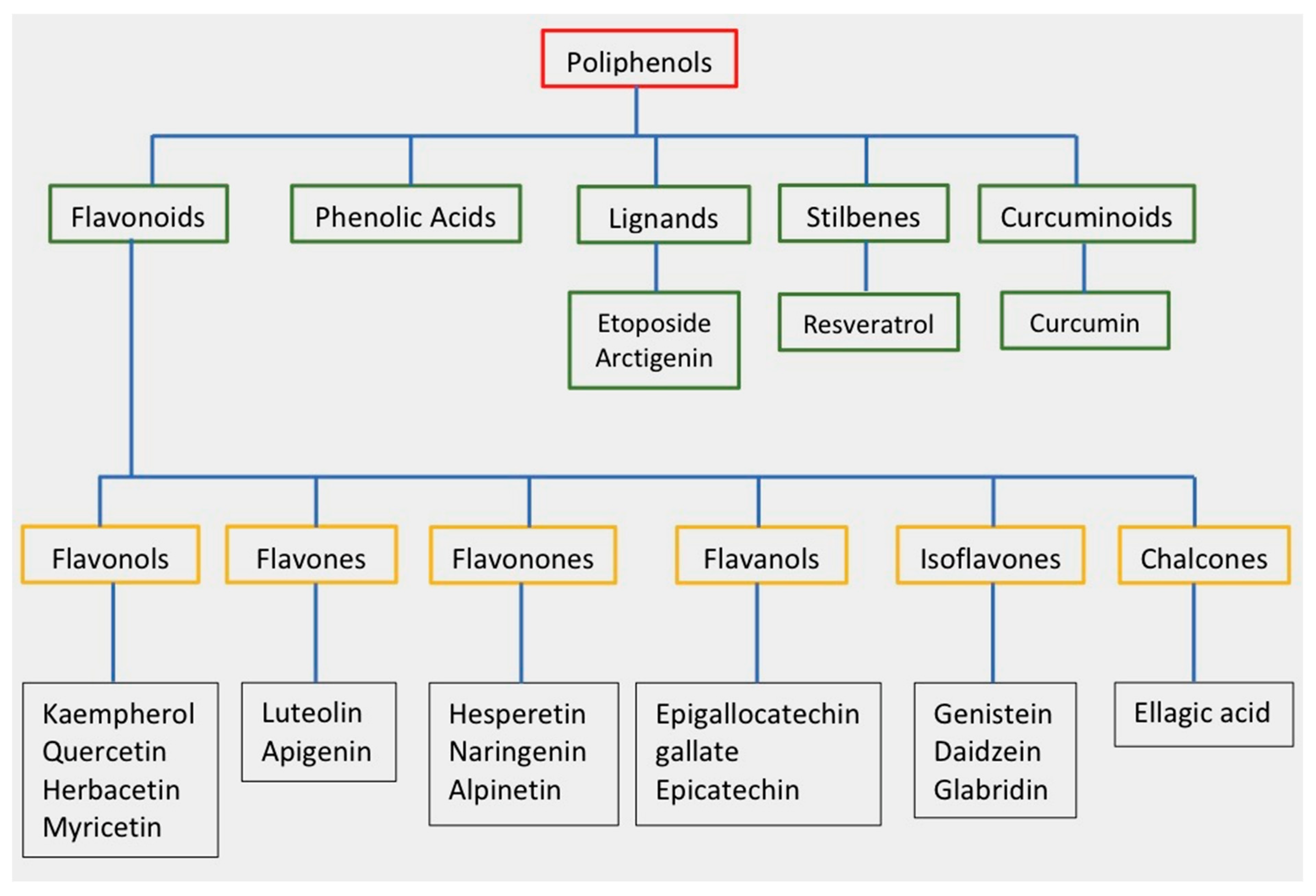1000/1000
Hot
Most Recent

| Version | Summary | Created by | Modification | Content Size | Created at | Operation |
|---|---|---|---|---|---|---|
| 1 | Szymon Roszkowski | -- | 2051 | 2023-06-14 00:24:22 | | | |
| 2 | Conner Chen | -32 word(s) | 2019 | 2023-06-19 02:48:26 | | |
The use of naturally derived drugs in anti-cancer therapies has grown exponentially in recent years. Among natural compounds, polyphenols have shown potential therapeutic applications in treatment due to their protective functions in plants, their use as food additives, and their excellent antioxidant properties, resulting in beneficial effects on human health. Building more efficient cancer therapies with fewer side effects on human health can be achieved by combining natural compounds with conventional drugs, which are typically more aggressive than natural chemicals with polyphenols.

| Flavonoids | Cancer Model | Mechanisms | Ref |
|---|---|---|---|
| Apigenin | Hepatocellular carcinoma doxorubicin-resistant cell BEL-7402/ADM Nude mice |
Sensitizes drug-resistant cells to doxorubic through suppressing miR-520b/ATG7 axis. | [43] |
| Breast cancer T47D, MDA-MB-231 |
Induction of protective autophagy and apoptosis. | [44] | |
| Colorectal cancer HCT116 |
Autophagy inhibitor significantly enhanced the apoptosis. | [45] | |
| Hepatocellular carcinoma Hepg2 |
Increases levels of Caspase-3, PARP cleavage, and Bax/Bcl-2 ratios. | [46] | |
| Non-small cell lung cancer EGFR-TKIs-resistant NCI-H1975 (Apigenin + Gefitinib) |
Inhibits the AMPK pathway and autophagy flux, leading to enhanced apoptotic cell death. Inhibits multiple oncogenic drivers such as c-Myc, HIF-1α, and EGFR, and reduces Gluts and MCT1 protein expression. Downregulates Cyclin D1, CDK4, E-cadherin, MMP2, and MMP9, and induces G0/G1 cell cycle arrest and cell metastasis. |
[47] | |
| Colorectal cancer cisplatin-resistant cell HT-29 |
Induces autophagic cell death and inhibits the growth of cells by targeting the m-TOR/PI3K/AKT signaling pathway. Autophagy inhibits the occurrence of MDR. |
[48] | |
| Breast cancer (MDA-MB-468), prostate cancer (PC3), | The investigated compounds cause intracellular copper mobilization and ROS production, resulting in cancer cell death. | [49] | |
| Baicalein | Prostate cancer PC-3, DU145 Breast cancer MDA-MB-231 |
Activation of AMPK and ULK1 and downregulation of mRNA level of mTOR/Raptor induces autophagic cell death. Upregulates the expression of Beclin1, Atg5, Atg7, ULK1, and LC3B-II. Induction of autophagic cell death. |
[50] |
| Breast cancer MCF-7, MDA-MB-231 |
Induces apoptosis and autophagy by inhibiting the PI3K/AKT pathway. | [51] | |
| Non-small cell lung cancer A549, H1299 |
Induces the loss of mitochondrial membrane potential and the release of cyto-c and apoptosis inducing factor into the cytoplasm. Induces autophagy and activates autophagy flux. |
[52] | |
| Human glioblastoma U87 and U251 cell lines |
Maturation of microtubule-associated protein 1A/1B-LC3B indicated the activation of autophagy potentially through the PI3K/Akt/mTOR pathway, and inhibition of autophagy by 3-methyladenine decreased the apoptotic cell ratio. | [53] | |
| Quercetin | Glioblastoma multiforme T98G (quercetin + temozolomide) Anaplastic astrocytoma MOGGCCM (quercetin + temozolomide) |
Activates ER stress, increases the level of caspase 12 expression, and changes the shape of nuclei. Inhibition of HSP expression results in severe apoptosis and no obvious signs of autophagy, which decreases mitochondrial membrane potential, and increases level of cyto-c in the cytoplasm and the activation of caspase 3 and caspase 9. |
[54] |
| Glioblastoma U251, U87 |
T-AUCB induces overexpression of Atg7 and regulates autophagy-related gene expression. | [55] | |
| Glioblastoma multiforme T98G (quercetin + sorafenib) |
In T98G cells, sorafenib mainly initiated autophagy, resulting in an increased number of autophagic cells with quercetin. | [56] | |
| Glioblastoma U373MG |
Activates JNK signal, increases the expression and translocation of p53 to the mitochondria, and causes the release of cyto-c into the cytoplasm. | [57] | |
| Melanoma (B16-F10) | Inhibits Akt/PI3 K and MEK-ERK signaling while augmenting UVB-induced nuclear translocation of NF-κb. | [58] | |
| Galangin | Laryngeal carcinoma TU212, HEP-2 |
Modulates apoptosis through caspase-3, caspase-9, and PARP cleavage activation and bcl-2 downregulation. Regulates apoptosis and autophagy by p38 and AKT/NF-κB/mTOR pathways. |
[59] |
| Epigallocatechin gallate |
Non-small cell lung cancer A549 (gefitinib-resistant cell)/ | Inhibits autophagy induced by gefitinib and promotes cell death. | [60] |
| Colorectal cancer HCT-116 |
The combined effect of epigallocatechin Gallate and quercetin caused cell cycle arrest at the G1 phase. | [61] | |
| Chalcone | Breast cancer Epirubicin-resistant cell MCF-7/ADR |
Induction of autophagy and G2/M checkpoint block and downregulation of ABCG2 expression, but no induction of apoptosis. Induces autophagic cell death through inhibition of miR-25 and upregulation of ULK1 expression. |
[62] |
| Breast cancer MCF-7 cells | Licochalcone A inhibits PI3K/Akt/mTOR activation and promotes autophagy and apoptosis in MCF-7 cells | [63] | |
| Malignant melanoma | Cell-cycle arrest at the G2/M phase was associated with modulation of expression or phosphorylation of specific cell cycle-associated proteins (cyclin B1, p21, and ChK1) and tubulins. | [64] | |
| Human uterine sarcoma | Induces A375 cells to differentiate and lose their pluripotency by inhibiting the expression of Notch1, β-catenin, and Oct-3/4 and targeting members of the key signals PI3K/Akt and MEK-ERK pathways. | [65] | |
| Ovarian cancer OVCAR5 and ES-2 | Isoliquiritigenin induced G2/M phase arrest. Furthermore, the expression of cleaved PARP, cleaved caspase-3, Bax/Bcl-2 ratio, LC3B-II, and Beclin-1 levels were increased in Western blot analysis. | [66] | |
| Human breast cancer | Cell-cycle arrest at G2/M phase and induced apoptosis and autophagy in human breast cancer cells. Interruption of the PI3K/AKT/mTOR/p70S6K/ULK signaling pathway. | [67] |